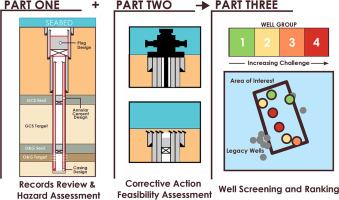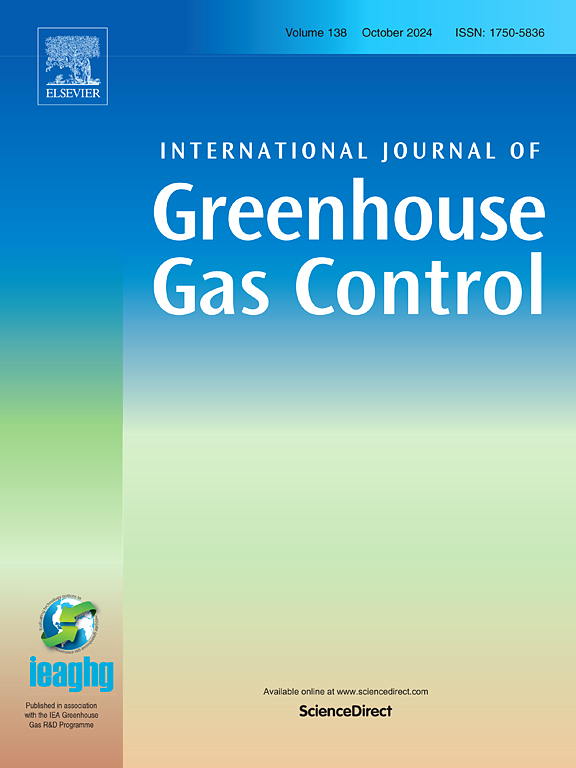评估用于地质碳封存的近海遗留井:墨西哥湾加尔维斯顿和布拉索斯地区案例研究
IF 4.6
3区 工程技术
Q2 ENERGY & FUELS
International Journal of Greenhouse Gas Control
Pub Date : 2024-10-28
DOI:10.1016/j.ijggc.2024.104276
引用次数: 0
摘要
墨西哥湾的联邦近海水域对大规模地质碳封存(GCS)很感兴趣。然而,该地区现有 8 万多口近海油气井,这可能会影响密封区间的完整性。在这项研究中,我们提出了一种筛选方法,根据海上遗留油井可能对 GCS 造成的挑战对其进行排序。该方法依赖于对油井监管记录的审查,以便:1)确定泄漏途径并评估油井对计划中的 GCS 作业构成的潜在危害;2)评估影响油井可及性的油井特征,以确定潜在纠正措施的可行性;3)根据油井可能对 GCS 构成的总体挑战对其进行排序。我们通过评估德克萨斯州墨西哥湾沿岸联邦浅水区 8 个相关区域 (AOI) 的 156 口油井的建造和废弃情况来展示我们的框架。大多数(99.3%)油井的建造和封堵方式都没有在上新世和下新世地层中隔离出潜在的全球陆地观测系统目标,可能需要在全球陆地观测系统之前采取具有挑战性或不确定的纠正措施。数据集趋势表明,所观察到的油井建造和堵塞设计可能在德克萨斯州墨西哥湾沿岸的近海联邦浅水区很常见。因此,在该地区实施近海 GCS 项目的运营商可考虑选择避免挑战性油井的区域,或对遗留油井泄漏风险进行严格评估,以便在注入二氧化碳之前计划纠正措施。本文章由计算机程序翻译,如有差异,请以英文原文为准。

Evaluating offshore legacy wells for geologic carbon storage: A case study from the Galveston and Brazos areas in the Gulf of Mexico
Federal offshore waters in the Gulf of Mexico are of interest for large-scale geologic carbon storage (GCS). However, more than 80,000 offshore oil and gas wells exist in the region, which could impact the integrity of sealing intervals. In this study, we propose a screening methodology for ranking offshore legacy wells based on the challenge they may present to GCS. The methodology relies on the review of well regulatory records to 1) identify leakage pathways and assess the potential hazards that wells pose to planned GCS operations, 2) evaluate well features that impact the accessibility of wells to determine the feasibility of potential corrective actions, and 3) rank wells based on the overall challenge they may pose for GCS. We demonstrate our framework by evaluating the construction and abandonment of 156 wells across eight areas of interest (AOIs) in shallow federal waters along the Texas Gulf Coast. The majority (99.3 %) of wells considered were constructed and plugged in a manner that did not isolate prospective GCS targets in the Upper and Lower Miocene formations and may potentially require a challenging or uncertain corrective action prior to GCS. Dataset trends suggest that the observed well construction and plugging designs may be common in shallow offshore federal waters along the Texas Gulf Coast. Consequently, operators pursuing offshore GCS projects in the region may consider selecting areas that avoid challenging wells or performing robust evaluations of legacy well leakage risks to plan corrective action prior to CO2 injection.
求助全文
通过发布文献求助,成功后即可免费获取论文全文。
去求助
来源期刊
CiteScore
9.20
自引率
10.30%
发文量
199
审稿时长
4.8 months
期刊介绍:
The International Journal of Greenhouse Gas Control is a peer reviewed journal focusing on scientific and engineering developments in greenhouse gas control through capture and storage at large stationary emitters in the power sector and in other major resource, manufacturing and production industries. The Journal covers all greenhouse gas emissions within the power and industrial sectors, and comprises both technical and non-technical related literature in one volume. Original research, review and comments papers are included.

 求助内容:
求助内容: 应助结果提醒方式:
应助结果提醒方式:


